Catholic Customs
 |
 |
 |
 |
 |
 |
 |
Fire: Symbol of the First Week of Lent
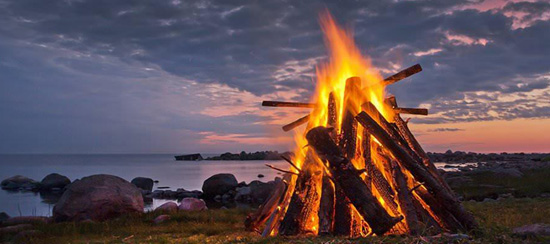
'Great fires' dot the landscapes in the first week of Lent
The First Sunday of Lent & fire
The First Sunday of Lent (Quadragesima) is the solemn opening of Lent in the Western Church. In Medieval Germany this Sunday is called "White Sunday" or "Spark Sunday."
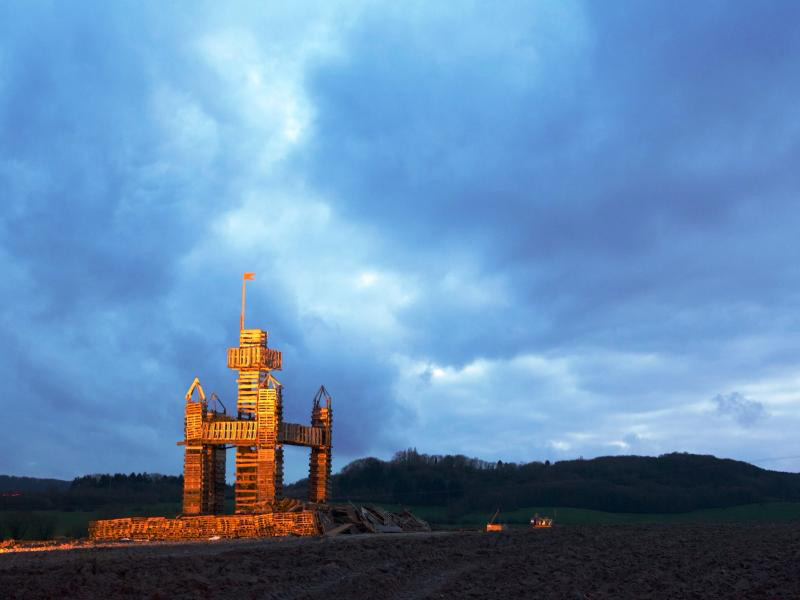
Grand pyres of wood & brush are constructed to be consumed on the First Sunday of Lent
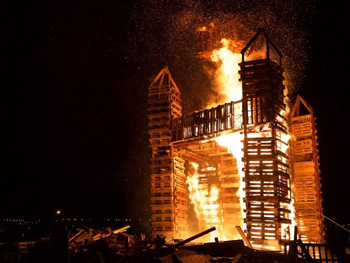
Fire is a fitting symbol for the first week of Lent signifying purification and punishment, two themes impressed deeply upon the minds of the faithful during Lent. Fires during this time of the year are also symbolic of the burning away of Winter to make way for the coming of Spring. Winter is symbolic of death and Spring of new life: thus must Lent drive out the Winter of death in our souls and bring the Spring of new life in Christ through His Resurrection.
In the Belgian Ardennes and parts of France, Luxembourg and Germany, this Sunday is known as the "Sunday of the Great Fires" (dimanche des Brandons or Buersonndeg). A few days before the Sunday, children or young men go from house to house begging for wood that is used to light the fires that will burn on every hilltop. (2) The young people are rarely turned away, because it is believed that if a family neglects its duty to contribute fuel for these fires, that family will suffer from a poor harvest. (3)
In Luxembourg and Germany, large pyres (called castles or buergen) are made with wood, straw, branches or pine trees, and a wooden or straw cross is raised above each pyre. The young people (more traditionally the young men) in larger cities process to the fire carrying burning torches that are thrown onto the pyre to light the bonfire. (4) Often, the most recently married man throws the first torch to light the fire.

A double symbol
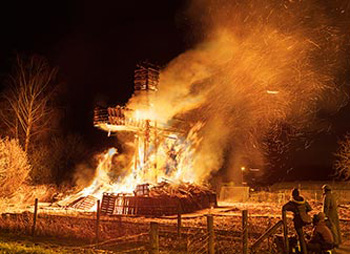
Once the fires are lit in Belgium, young men and women dance around them asking God to give good success to their crops in the coming year. In parts of Germany, it is traditional for men to run around the fires holding flaming torches and to attempt to leap over the flames. (6) At the end of the bonfire in Luxembourg, a newly-wed couple welcomes all the young people to their home for refreshments and convivium.
In Belgium, it was believed that if a man saw seven fires he would be free from the power of witches. Children were told that they would receive as many Easter eggs as fires that they saw on this night. The fires were so prized that the Belgians believed that anyone who did not light the "great fire" would be chastened by God, Who would send fire to burn the house of the obstinate person. (7)
In the past, the Germans not only lit bonfires but also sent the flaming wood structures down the hillsides. German men and boys near the border of Hesse and Bavaria and in the Eifel Mountains of Rhenish Prussia set ablaze a wheel made of wood and other combustibles and chased it down a hillside carrying flaming torches as they ran.
When the wheel crashed at the bottom of the hill, the men burst into traditional songs and carried their lighted torches through the fields. These fires were lit to honor Our Lady who brought the true Light into the world and to drive away the demons. The men hoped that Our Lady would reward this gesture by blessing the fields and protecting them from hail storms.
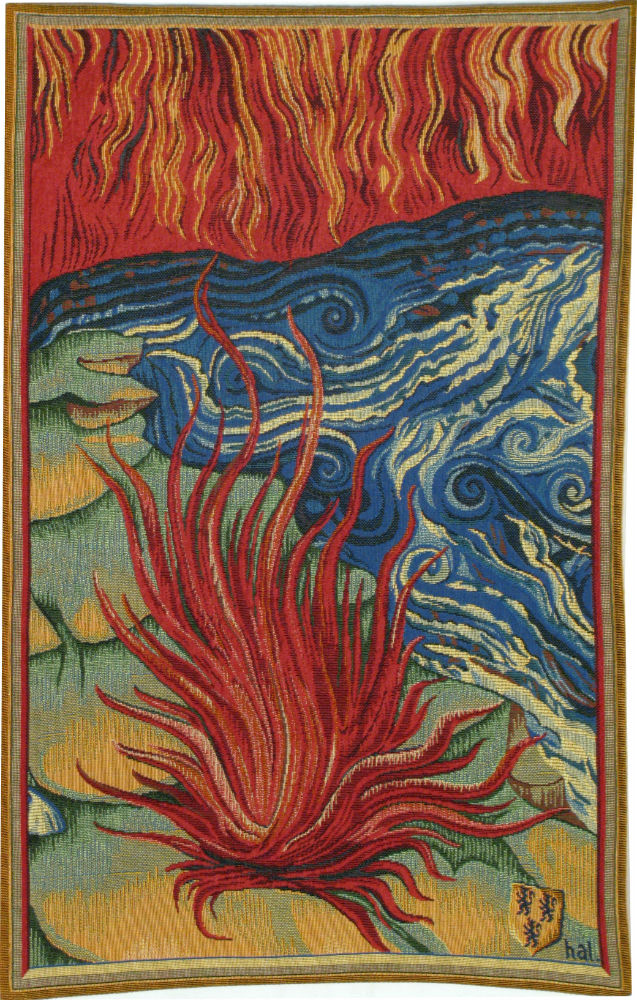
Fire will consume the water and land in the Apocalypse
In Hungary, the girls of the village, singing a traditional song, walked around a simple wooden hut constructed by the village boys earlier in the day. At the conclusion of the song, the girls all knelt down to pray. One girl was chosen to light the hut with the flame of a blessed candle.
Then the boys lit their wooden rings (sajbos) until they glowed with flames. The strongest boy shouted: "This sajbo belongs to the Holy Virgin!" Then, he used a stick to throw his flaming ring against a plank and send it flying into the night sky. All of the boys followed suit, with rings tossed for all their patron saints as well as for fathers, mothers, sweethearts, fellow villagers and even gypsies. (9)
Lent is a time of purification and penance, a time for the old man to die with Christ in order to rise again with Him. What better way to illustrate this truth than by lighting fires at the beginning of Lent? The fire symbolizes the burning away not only of Winter and Carnival, but also the last vestiges of sin and the disordered passions.
These fires lit at the beginning of Lent also are a preamble for the Easter fires soon to follow. If the fire of penance and mortification cleanses our souls during Lent, the Easter fires will bring hope.
But woe to the man who does not allow the fire of penance and mortification to cleanse his soul for Easter. For such a man, the Easter fire, instead of bringing hope, serves merely as a reminder of the fires of Hell or Purgatory that he will have to undergo because he did not allow the graces of Lent to purify his soul.
Continued
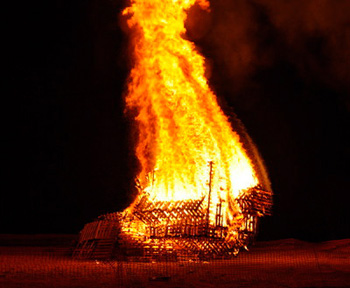
- Prosper Guéranger, The Liturgical Year, vol. V (Fitzwilliam, New Hampshire, Loreto Publications, 2013) p. 121.
- Dorothy Gladys Spicer, Festivals of Western Europe (New York: The H. W. Wilson Company, 1958), p. 17.
- http://www.brauchtumsseiten.de/a-z/b/burgsonntag/home.html
- https://web.archive.org/web/20220207024718/https:/www.luxtimes.lu/en/luxembourg-guide/what-is-buergbrennen-602d6e5ade135b9236b7c42a
- E. I. Robson, A Guide to French Fêtes (London: Methuen and Company, 1930), p. 75.
- http://www.brauchtumsseiten.de/a-z/b/burgsonntag/home.html
- D.G.Spicer, Festivals of Western Europe , p. 17.
- http://www.maggieblanck.com/Germany/Customs.html
- Károly Viski, Hungarian Peasant Customs (Budapest: Dr. George Vajna and Company, 1932), p. 36-37.

Posted March 5, 2022
______________________
______________________
 |
 |
 |
 |
 |
 |


